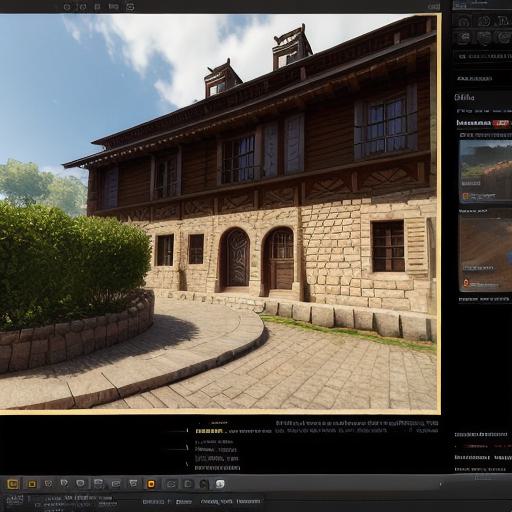The Art and Science of Creating Viral Content: Uncovering the Best Features of Houdini Game Development Toolset
Introduction
In today’s fast-paced, technology-driven world, video games have emerged as one of the most popular forms of entertainment. From casual mobile games to complex, immersive experiences, game development has become a lucrative and thriving industry. In order to succeed in this competitive landscape, game developers need access to powerful, flexible, and efficient tools that can help them bring their creative visions to life. One such toolset is Houdini, an innovative and versatile software suite developed by Side Effects Technologies. In this article, we will explore the best features of Houdini, delving into its unique capabilities, user-friendly interface, and real-world applications. We will also discuss how Houdini can help game developers create viral content that resonates with audiences and drives business growth.
What is Houdini?
Houdini is a comprehensive software suite designed for creating 3D animation, visual effects (VFX), and game development. It was first released in 2016 by Side Effects Technologies, a Canadian-based company with a rich history of innovation and excellence in the media industry. Houdini quickly gained popularity among artists, designers, and developers due to its powerful set of tools, intuitive interface, and seamless integration with other software platforms.
Key Features of Houdini
- Scene Layout and Navigation
One of the most significant advantages of Houdini is its user-friendly scene layout and navigation system. This feature allows users to easily organize their scenes, assets, and workflows, making it easier to manage complex projects with multiple team members. Users can create custom folders, tags, and categories for their resources, enabling them to quickly locate and access the information they need. Additionally, Houdini’s scene graph view provides a visual representation of the relationships between objects, materials, and other elements in the scene, allowing users to identify potential issues and optimize performance.
- Modeling and Animation
Houdini offers a wide range of modeling tools, including primitive shapes, extrusions, subdivisions, and more. These tools enable artists and designers to quickly create detailed, high-quality 3D models for games, films, and other applications. Houdini also supports advanced animation techniques such as keyframe animations, physics-based simulations, and procedural animation, allowing users to bring their characters and objects to life with stunning realism and fluid motion.

- Texturing and Lighting
Another key feature of Houdini is its powerful texturing and lighting capabilities. Users can apply a wide variety of materials, textures, and shaders to their models, giving them the appearance of real-world objects and environments. Additionally, Houdini includes advanced lighting tools such as global illumination, radiosity, and ambient occlusion, allowing users to create stunningly realistic lighting effects that enhance the overall look and feel of their scenes.
- Visual Effects (VFX)
Houdini’s VFX capabilities are truly unparalleled, offering a comprehensive set of tools for creating complex visual effects such as particle systems, fluids, smoke, fire, and more. These features enable users to simulate realistic physical phenomena and create visually stunning effects that would be nearly impossible to achieve with traditional 3D software. Houdini’s VFX tools also integrate seamlessly with other popular VFX software platforms, such as Maya and Nuke, allowing users to leverage the strengths of multiple applications in their workflows.
- Game Development Tools
Houdini includes a suite of game development tools that enable users to create interactive, immersive experiences for various platforms, including PC, console, and mobile. These tools include features such as animation rigging, scripting, and AI integration, allowing users to bring their games to life with engaging, intelligent characters and dynamic, responsive environments. Houdini also supports advanced networking and multiplayer functionalities, enabling developers to create massively multiplayer online (MMO) games and other large-scale, cooperative experiences.
Case Studies and Real-World Applications
- The Lion King Remake
One of the most notable examples of Houdini’s success in game development can be found in the creation of the visually stunning, realistic world of The Lion King remake. Developed by Disney Interactive Studios and powered by Houdini, this game showcases the software’s advanced modeling, texturing, lighting, and VFX capabilities, as well as its integration with other popular gaming engines such as Unity. By leveraging the strengths of these platforms, the development team was able to create a breathtakingly realistic African savannah environment filled with lifelike creatures and dynamic, interactive elements.

- Marvel’s Spider-Man: Homecoming
Another example of Houdini’s versatility and power can be seen in the creation of Marvel’s Spider-Man: Homecoming. This critically acclaimed video game was developed by Insomniac Games and featured stunning, realistic visuals that captured the essence of the iconic superhero. To achieve these impressive results, the development team utilized Houdini’s advanced modeling, texturing, lighting, and VFX tools, as well as its seamless integration with other software platforms such as Unreal Engine. By combining the strengths of these applications, the team was able to create a rich, immersive gaming experience that showcased the full potential of Houdini’s capabilities.
- Houdini in Education and Training
Houdini is also gaining popularity in educational and training contexts, thanks to its user-friendly interface, powerful features, and versatility. Institutions such as universities, art schools, and vocational training programs are incorporating Houdini into their curricula, enabling students to gain hands-on experience with cutting-edge 3D development tools and technologies. This practical, hands-on approach not only enhances student learning but also prepares them for real-world careers in the gaming and media industries.
The Power of User Communities and Plugins
One of the key strengths of Houdini is its vibrant user community, which includes artists, designers, developers, and other professionals from around the world. This community provides a valuable resource for users seeking guidance, inspiration, and support, as well as access to a wide variety of plugins, tools, and assets that can enhance their workflows and expand the capabilities of Houdini.
Some popular Houdini plugins include:
- Houdini Engine: A plugin that enables users to export their scenes and projects directly from Houdini into Unity, Unreal Engine, or other game engines, streamlining the development process and allowing for seamless integration with other software platforms.
- Houdini Indie: A free version of Houdini designed specifically for independent developers and small studios, offering a subset of the full software’s features at a more accessible price point.
- Houdini Education: A specialized version of Houdini tailored to educational institutions, providing students with access to the software’s core features and tools while simplifying the user interface and customizing the workflow for classroom use.
- Houdini Toolbox: A collection of pre-built tools, assets, and scripts that enable users to quickly create complex visual effects, animations, and game elements without having to build everything from scratch.
Comparing Houdini with Other Game Development Tools
While Houdini is a powerful and versatile 3D development platform, it is not the only option available for game developers. Some popular alternatives include:
- Unity: A cross-platform game engine that supports both 2D and 3D development, offering a user-friendly interface, extensive community support, and access to a wide variety of assets and tools.
- Unreal Engine: Another popular game engine that focuses on realism and visual fidelity, with advanced graphics, physics, and animation capabilities, as well as support for virtual reality (VR) and augmented reality (AR).
- CryEngine: A high-performance game engine that prioritizes real-time rendering and performance optimization, with advanced graphics, physics, and AI features, as well as support for VR and AR.
- Autodesk Maya: A professional 3D modeling and animation software that offers a wide range of tools and capabilities for creating complex visual effects and game elements, but may have a steeper learning curve than Houdini.
When comparing Houdini with these other platforms, it is essential to consider the specific needs and goals of your project, as well as the skills and expertise of your team. Each software offers unique strengths and weaknesses, and choosing the right tool for the job requires a thoughtful, informed decision-making process.
Summary: The Benefits of Houdini in Game Development
Houdini is a powerful and versatile 3D development platform that offers a wide range of tools and capabilities for creating engaging, immersive games and interactive experiences. Its user-friendly interface, advanced features, and seamless integration with other software platforms make it an attractive option for developers, artists, and designers seeking to push the boundaries of what is possible in the world of 3D gaming.
By leveraging the strengths of Houdini and its vibrant user community, developers can create breathtakingly realistic worlds, dynamic characters, and engaging gameplay experiences that captivate players and leave a lasting impression. Whether you are a seasoned professional or just starting out in your career, Houdini is certainly worth exploring as a valuable tool for enhancing your 3D development workflow and pushing the limits of what is possible in the world of gaming.



